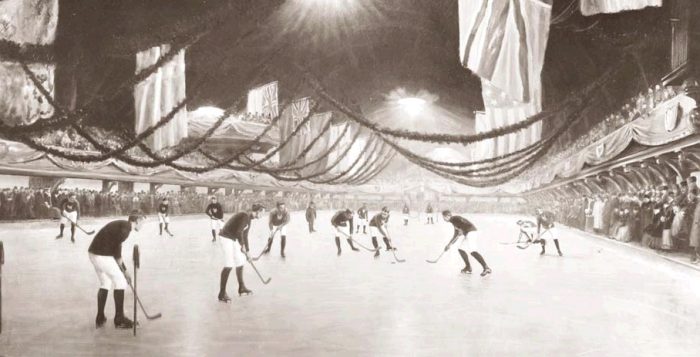This Day in Hockey History – March 3, 1875 – Montreal Brings In Hockey
(Image: Victoria Rink, 1893, via Wikimedia Commons)
On March 3, 1875, the Montreal Gazette advertised, “A game of Hockey will be played at the Victoria Skating Rink this evening . . . Good fun may be expected, as some of the players are reputed to be exceedingly expert at the game.” The claim of expertise is interesting because that would be the very first recorded public indoor hockey game in North America.
Victoria Skating Rink was located downtown, at 49 (now 1187) Drummond Street, bracketed between Drummond Street and Stanley Street and between Saint-Catherine Street and Dorchester Boulevard (now René Lévesque Boulevard). It was in the vicinity of McGill University, and the Bell Center (Centre Bell) is just a couple blocks down. The rink was built in 1862 and let the cold weather naturally create and keep the ice surface (measuring 204 by 80 feet (62 by 24 meters)). It later became the first electrified building in Canada. Until 1875, Victoria Skating Rink hosted figure skating, speed skating, and masquerade balls, but hockey was only played outdoors. Although unheated, Victoria Skating Rink would at least protect players from the elements and provide smooth ice. Thus, James Creighton of McGill asked (perhaps bribed) the caretaker to allow hockey players in when the rink was otherwise closed.
Outside, ice surfaces varied in size, so as many participants as would fit could play. With the move indoors, the teams would have to be more restricted. They decided to play with nine men on each side (without substitutions), and that would hold until the number was reduced at the Montreal Winter Carnival in 1883. The players mostly were McGill University students, including key organizer and captain Creighton, who left his native Halifax to study law at McGill in Montreal and was a member of the Victoria Skating Club. Creighton’s team consisted of Robert Esdaile, Henry Joseph, Frederick C. Henshaw, William B. Chapman, Robert H.W. Powell and Edward S. Clouston, Lorne Campbell, and his brother George Campbell. The other captain, Charles E. Torrance, had teammates Daniel Meagher, Thomas J. Potter, Edwin H. Gough, William M.S. Barnston, George W. Gardner, W.O. Griffin, Francis Jarvis and a man who’s last name was Whiting.
Soon the players wanted to move beyond practicing and play before audiences. The first game drew “a very large audience gathered to witness a novel contest on the ice.” Playing inside had the benefit of better viewing for spectators, but having them all in the confined space generated additional logistical challenges. According to the Montreal Gazette advertisement of the first game, “Some fears have been expressed on the part of intending spectators that accidents were likely to occur through the ball flying about in too lively a manner, to the imminent danger of lookers on, but we understand that the game will be played with a flat circular piece of wood, thus preventing all danger of its leaving the surface of the ice.” Instead of using a lacrosse ball or road apple (frozen horse manure), they invented something that would give players more control, the hockey puck.
With these first games, the players had a hand in codifying rules for the game of hockey, including setting the time for the two halves and preventing forward passing. The Montreal Gazette explained, “The game is like Lacrosse in one sense — the block having to go through flags placed about 8 feet apart in the same manner as the rubber ball — but in the main the old country game of shinty gives the best idea of hockey.”
As for that first match, the Gazette summarized, “The match was an interesting and well-contested affair, the efforts of the players exciting much merriment as they wheeled and dodged each other, and notwithstanding the brilliant play of Captain Torrance’s team Captain Creighton’s men carried the day, winning two games [goals] to the single of the Torrance nine. The game was concluded about half-past nine, and the spectators then adjourned well satisfied with the evening’s entertainment.”
Apparently, the game ran over its allotted time, causing an “unfortunate disagreement” in the crowd. The Daily Witness reported, “One little boy was struck across the head, and the man who did so was called to account, a regular fight taking place in which a bench was broken and other damage caused.” The Daily British Whig (a Kingston, Ontario paper) reported that the fight broke out when figure skaters arrived and became angered at not being able to use the ice. “Shins and heads were battered, benches smashed and the lady spectators fled in confusion.” Either way, the first indoor hockey game had the first indoor hockey fight among the fans rather than the players.
Additional Sources:
- Mike Commito, Hockey 365: Daily Stories from the Ice (Toronto: Dundurn, 2018), kindle version.
- https://mcgillathletics.ca/news/2015/5/22/MHOCKEY_0522155837.aspx?path=mhockey
- https://www.mcgill.ca/channels/news/week-history-worlds-first-organized-hockey-game-was-played-march-3-1875-104900
- https://montrealgazette.com/opinion/columnists/second-draft-in-1875-at-the-first-indoor-hockey-game-guess-what-broke-out
- https://www.cbc.ca/news/canada/montreal/montreal-hockey-first-ever-mcgill-1.3475181














